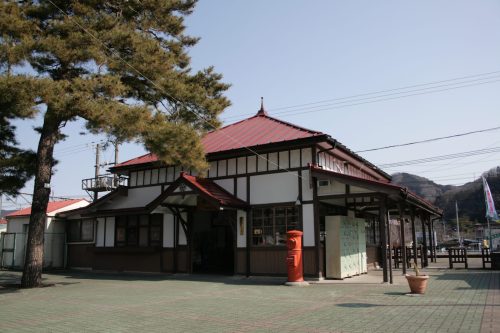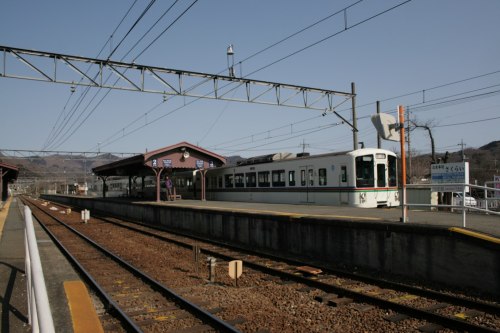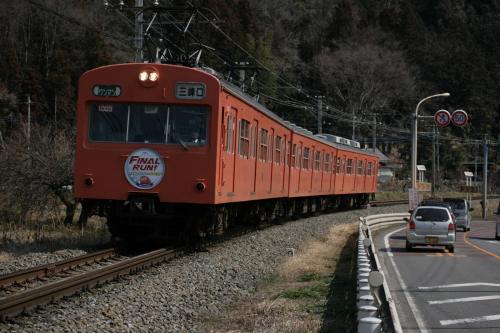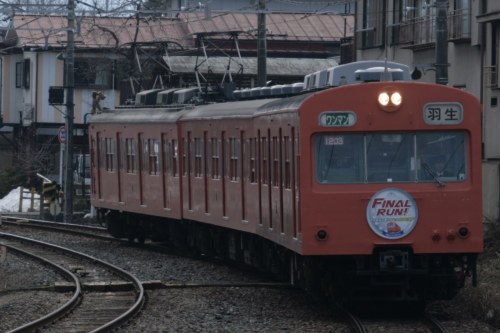
|
|
|
テーマ:鉄道(23025)
カテゴリ:鉄道日記
9日、今月に引退する秩父鉄道1000系を撮りに行った。
秩父鉄道は先日の大雪の影響が心配されたが、2月26日までに全線が復旧し、3月3日より西武池袋線直通列車も運転再開し、平常どおりとなった。しかし全線での運転再開後、当の主役に不具合が見つかり、3月1日・2日両日は別の車両での運行となってしまった。6日に復旧を終え、8日より予定通りの運用で営業運転に復帰した。 朝、池袋線・西武秩父線から秩父鉄道へと直通する西武4000系に乗って行くことに。この列車が走る西武西武秩父線横瀬駅から秩父鉄道御花畑駅への連絡線には乗ったことがなく、今回が初乗車の区間となる。   終点の長瀞駅まで乗り、後続の列車に乗り換えて波久礼駅へと向かう。駅を降りたら樋口方へ戻るように線路沿いを歩く。波久礼~樋口間は秩父の緑を背景に走る列車が撮れることで有名な撮影地。  次に向かった場所は大野原駅。ここで三峰口駅から折り返して来た列車を撮る。風光明媚さはないが三峰口方がカーブしているため羽生行き列車が撮影しやすい。  早速1003Fに乗車した。僕が乗ったのは、2号車で元モハ101-118の1103。冷房改造されていない、オリジナルにもっとも近い姿を保っている車両である。昨年2013(平成25)年5月に乗った1109Fと1101Fに続いて、今回で秩父鉄道1000系最後の3本全てに乗ることができた。 1003Fは、元クモハ100-133の1003、元モハ101-118の1103、元クハ101-62の1203の3両から成る。新製配置は、クモハとモハが池袋電車区、クハが津田沼電車区(後の習志野電車区)である。クモハとモハは1962(昭和37)年製で、最初に山手線で活躍し、1969年に津田沼に転属し、中央・総武緩行線で活躍した。クハは1965(昭和40)年製で、デビューから引退まで中央・総武緩行線から一度も離れることがなかった車両である。国鉄での最終配置は3両とも津田沼電車区で、1986(昭和61)年に秩父鉄道に譲渡された。 2011(平成23)年8月25日より、前年に廃車となった1011Fに代わる2代目オレンジバーミリオン塗装となった。前述の通り、国鉄時代は山手線と中央・総武緩行線運用に充てられていたため、カナリヤ色(「黄色5号」)塗装だった(山手線に黄緑色のラインカラーが設定されるのは1963(昭和38)年の103系登場時からで、101系はカナリヤ色塗装だった)。そのため、国鉄時代は101系の伝統色であるオレンジバーミリオン(朱色1号)に塗装されたことが一度もなかったのだった。 車内は国電時代を知る中高年世代から、それを知らない若者世代まで、多くの人々が乗っており、別れを惜しんでいた。僕は旅の道中、ロングシートに腰掛けたり、立って吊り革を握りしめたりしながら、昭和の「国電」の雰囲気を味わった。既にさまざまな箇所に年季が入った車内は、僕が幼いころに乗っていた東海道線の113系に似た、懐かしさを持っていた。 今となっては縦揺れ、横揺れともに激しく、とても乗り心地がよいものとは言い難いが、101系が誕生した昭和30年代の人々にとっては、カルダン駆動などの新機軸の採用で、旧来の釣りかけ式の車両と比べて乗り心地が改善されたと感じたのではなかろうかと想像した。 終点の羽生駅まで乗ろうと思っていたが、時間の都合で今回の乗車は熊谷駅まで。最後の最後に国鉄101系という日本の鉄道史に新たな1ページを刻んだ名車両に乗ることができて、よい思い出となった。 参考文献:鉄道ピクトリアル 2013年4月号 特集「101系電車」 On 9th, I went photographing Chichibu Railway 1000 Series, which is former Japan National Railway 101 Series and going to retire within the end of this March. Because of the heavy snow in this February, the train operation on Chichibu Railway Line had been suspended. On February 26th, it restarted along the entire line and the trains from/toward Seibu Ikebukuro Line also did from March 3rd. However, a new worry happened soon after the restart; 1000 Series got out of order. the operations by it planned on March 1st and 2nd were cancelled. Luckily, it could come back to the regular operation on March 8th. On the morning of that day, I travelled with a train going through Chichibu Railway Line to Nagatoro by Seibu 4000 Series, which was first time for me to go there without the transfer at Seibu-chichibu Station. Transferring at Nagatoro Station, I first went to Hagure where many photographers come because of the beautiful greenery against the railway. Where I went next was Onohara Station. I photographed it coming back from Mitsumineguchi. Though there was no beautiful scenery, the railway toward Mitsumineguchi curved, so it could be easy to photograph the sets from the front to the rear. I got on the middle carriage of it, 1103 (former Moha 101-118), which didn't have cooler and kept almost its original. I could all of the last 3 sets of 1000 Series, following 1009F and 1001F, by which I travelled in 2013. 1003F set consisted of 1003 (Kumoha 100-133), 1103, and 1203 (Kuha 101-62). 1003 and 1103 were first built in 1962 and assigned to Ikebukuro train shed for Yamanote Line, then transferred to Tsudanuma (later Narashino) for Chuo Sobu Line local service in 1969. 1203 was built in 1965 and assigned to Tsudanuma since then. All of them transferred to Chichibu Railway in 1986. Since August 25th in 2011, the set changed its body colour to orange which is the same as Chuo Line rapid service train instead of 1011F set retiring in the year before. As already stated, because the 3 had been in service on Yamanote and Chuo Sobu Lines with yellow colour (the symbol colour of Yamanote Line set green in 1963), they haven't been coloured by orange, which is used since 101 Series first debuted in 1957, when they belonged to the National Railway. There were many passengers in the train from middle-agers who probably know when 101 Series running on National Railways to youngsters who don't know. During the travel, I felt the atmosphere of the old commuter train, which reminded me that of 113 Series on Tokaido Line when I was little, by sitting on the longitudinal seat and holding a strap. Due to heavy pitching and rolling it is difficult to say the ride quality was good, but I also felt persons in 1950s and 1960s had done 101 Series could have been better than the older ones for because of its new technologies such as parallel cardan driving device. I first planned to go Hanyu terminal, but I got off at Kumagaya. It became my memorable travel with a great historical unit, National Railway's 101 Series. Reference: Railway Pictorial April 2013 issue "101 Series"
お気に入りの記事を「いいね!」で応援しよう
最終更新日
Mar 13, 2014 04:43:21 AM
コメント(0) | コメントを書く
[鉄道日記] カテゴリの最新記事
|